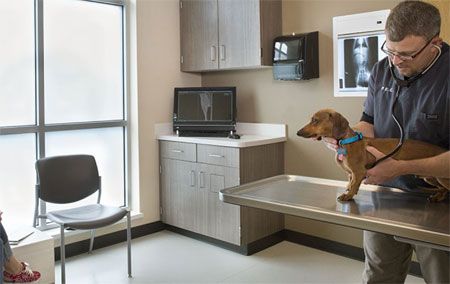Building a Fear Free practice
Fear Free facility standards can improve the relationship between pets and your veterinary practice, whether youre looking to build, renovate or make some anxiety-reducing updates.

Studies have shown that daylighting provides the same healing benefits to animals that is does to humans. Pet Emergency Clinic & Referral Center in Spokane, Washington | Photo courtesy of Tim Murphy, Murphy Foto Imagery
More than 33,000 veterinary professionals have registered for Fear Free individual certification and, as of April 2018, practices can register their facility for certification. Part of this certification is that the practice has to meet specific facility standards. As veterinarians continue to seek ways to improve the relationship between anxiety-prone pets and their practices, Fear Free facility standards could help practices build, remodel or update their spaces to distinguish themselves in the marketplace.
Good Fear Free hospital design creates a harmonious interaction between practice, client and pet and should include the following:
Reduced wait times
Fear Free encourages shorter wait times, decreasing the chances a pet will become anxious when faced with strange people, pets and places. Some practices ask clients to send a text from their car when they arrive, while others have started introducing direct exam room entrances from the outside of the building. Either way, less square footage can be devoted to waiting areas and given to exam and treatment areas.
Separation of species
The intermingling of dogs, cats and other animals can increase anxiety in pets before they reach the exam room. In an ideal world, a practice would have separate exam and treatment rooms for dogs and cats, but more realistically, visual barriers should be set up between dogs and cats in the treatment area, much like treatment curtains in human medicine. In addition, since dogs often make noise in wards, cat and dog wards should not share a common wall.
Fear Free design for dogs
When designing hospitals for dogs, it's important to minimize anxiety-triggering distractions. For instance, using excessive restraint or lifting dogs onto a shiny exam table could be prevented with an outdoor exam option. For more traditional indoor exam rooms, non-slip flooring is paramount-dogs often become anxious when floors look and feel slippery.
Fear Free design for cats
It might be easier to list things that aren't stressful to cats during a visit to the vet. Cats are most often stressed out by confinement, transport, changes in environmental temperature and/or ventilation, light patterns, unfamiliar smells, noises, dogs, other cats, irregular schedules, unpredictable handling, the presence of unfamiliar human contact, the inability to engage in natural feline behaviors and the lack of control over the environment. Some great first steps to reducing feline anxiety in the exam room include high, stable platforms for cat carriers and climbing structures cats can comfortably perch on. (Just make sure the climbing structure isn't so high that you can't reach the cat!)
Fear Free housing
It's important that enclosures used for overnight stays are designed to reduce fear and anxiety. Dog enclosures should prevent dogs from looking at other dogs across the aisle, provide a view outside the dog's enclosure at dogs-eye level and allow for a temporary barrier to be put up in the case of an extremely anxious dog. Fear Free enclosures for cats should allow normal feline behaviors. Preferably, cat enclosures should be 36 inches long and not reflective.
Other Fear Free features
Lighting
> Studies have shown that daylighting provides the same healing benefits to animals that is does to humans. Daylighting can be achieved through the use of exterior windows, high-light shelves, clerestory lighting, skylights or light tubes, such as Solatubes.
> Artificial lighting should be dimmable. When full lighting levels are not necessary, dim the lights to avoid stressing out the animal.
Sound
Minimize high- and low-frequency noises (which both cats and dogs can hear more acutely than humans) by:
> Placing rooftop mechanical equipment over spaces other than animal wards
> Using mechanical equipment with internal vibration isolation
> Replacing old fluorescent lighting with fixtures with electronic ballasts, eliminating the buzzing noises of older fixtures
> Placing other motors and mechanical equipment, such as vacuums, pumps, etc., in closets well away from animals.
Ventilation
> Ward spaces should be negatively pressurized-meaning more air is exhausted than supplied from these spaces-to control the spread of odors and airborne contaminants.
> Strategically place pheromone dispensers in cat and dog wards, exam rooms and treatment areas for anxiety reduction. (Pheromone distributors can be great resources for placement ideas.)
Even if you're not ready for a full Fear Free redesign of your hospital, changing even just a few features can get you on the path to lower pet stress and increased client satisfaction.